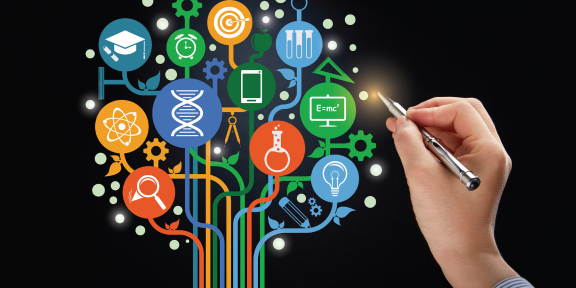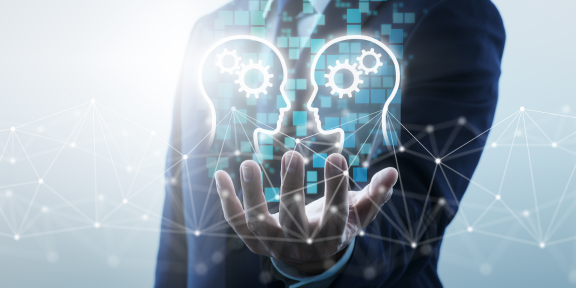Driving Innovation and Creativity in the Classroom with AI

Welcome to the future of Innovation and creativity in the classroom! The integration of artificial intelligence (AI) in classrooms is driving innovation and creativity, transforming traditional teaching methods and fostering a technology-driven learning environment. With AI, teachers can create personalized learning experiences that cater to each student’s unique needs, promote collaboration, and enhance critical thinking skills.
The impact of AI in education is already evident, and it’s only going to get more prevalent. As educators strive to prepare students for an increasingly digital world, AI-powered learning platforms are emerging as a game-changer. In this article, we will delve into the world of AI in education, explore its role, benefits, and challenges, and provide practical insights into integrating it into the existing curriculum.
The Role of AI in Education
As the world becomes increasingly tech-driven, education must keep pace with the changing times. Artificial intelligence (AI) is one such technology that is transforming education by boosting the learning experience for students and making teaching more effective for teachers. The use of AI in education is reshaping traditional education models, creating more personalized and adaptive learning experiences for students.
AI-powered learning platforms are proving to be an essential tool for educators. They are being used to analyze student performance, assess learning gaps, and provide immediate feedback. This allows teachers to tailor instructional methodologies to better suit the needs of individual students. AI-based tools are also making it possible for students to learn at their own pace, taking advantage of self-paced learning modules that dive into topics based on readiness and performance.

The Benefits of AI in Education
The benefits of using AI in the classroom are vast, impacting both students and teachers. One of the most significant advantages is personalized learning. With AI-powered learning, students can receive personalized recommendations based on their interests and learning style. This allows students to better engage with the material, resulting in higher levels of retention and greater academic success.
AI can also support student engagement by making the learning experience more interactive and immersive. This is particularly important in an era where attention spans are low and students are increasingly used to receiving information in bite-sized chunks. By using gamification techniques and immersive technologies, educators can create a fun and engaging learning environment that keeps students motivated and excited about learning.
Finally, AI can help teachers be more effective in the classroom by providing real-time feedback on student performance, simplifying administrative tasks, and providing new teaching tools to make classroom interactions more effective. This ultimately leads to a more productive learning experience for all involved.
Fostering Creativity with AI
Artificial intelligence has the potential to enhance creativity in the classroom by providing teachers with innovative tools and approaches. AI-powered platforms can encourage students to think critically, creatively, and collaboratively, while also providing real-time feedback on their progress.
One example of an AI tool that fosters creativity is the virtual whiteboard. This technology allows for collaborative brainstorming sessions that would not be possible with traditional whiteboards. Students can sketch and draw on the virtual board while also collaborating with their peers in real time. Additionally, AI algorithms can analyze the students’ work and provide suggestions for improvements, allowing them to experiment with different ideas and approaches.
| Benefits of Using a Virtual Whiteboard in the Classroom |
|---|
| Encourages collaboration and communication among students |
| Provides real-time feedback on students’ work |
| Allows students to experiment with different ideas and approaches |
Another AI-powered tool for fostering creativity is the intelligent tutoring system. These systems use AI algorithms to adapt to the learning needs of individual students, providing personalized learning experiences that can improve students’ creativity and problem-solving skills. These systems can track students’ progress, identify areas where they need more support, and provide targeted feedback to help them overcome challenges.
AI can also support project-based learning, by providing students with data to analyze, algorithms to develop, and models to test. This approach is particularly effective for nurturing creativity and innovation, as it gives students the freedom to explore topics of their choice and develop their own solutions to real-world problems.
By using AI-powered tools and approaches, educators can foster creativity and innovation in their classrooms, helping to prepare students for the demands of the 21st century workforce.

AI-driven Innovations in Education
Artificial intelligence is transforming education by unleashing a wave of innovations that promise to revolutionize the classroom experience. Here are some examples of how AI is driving innovation in education:
| Innovation | Description |
|---|---|
| Interactive Learning Experiences | AI-powered learning platforms enable students to interact with rich media content, such as videos, simulations, and games. These immersive experiences help students to understand complex concepts and retain information more effectively. |
| Intelligent Tutoring Systems | AI-powered tutoring systems use machine learning algorithms to provide customized learning experiences for each student, based on their individual needs and learning styles. These systems can adapt to students’ progress in real-time, providing instant feedback and remediation where necessary. |
| Adaptive Assessments | AI can help to create assessments that are more accurate and personalized for each student. By collecting data on students’ learning progress, AI can adjust the difficulty and content of assessments to match each student’s level of understanding. This ensures that students are challenged, but not overwhelmed, by the assessment process. |
AI-driven Innovations in Education: Implications
The rise of AI-driven innovations in education has transformative implications for the future of learning. By leveraging cutting-edge technologies, educators can create learning experiences that are more engaging, effective, and personalized for each student. This can help to close the achievement gap and improve students’ performance across the board.
However, the use of AI in education also raises ethical and practical concerns. Educators must be mindful of issues such as data privacy, algorithmic bias, and the responsible use of AI technology in the classroom. Addressing these concerns will be critical to ensuring that AI-powered classrooms are safe and effective learning environments for all students.
Benefits of AI in the Classroom
Integrating artificial intelligence (AI) into the classroom can have several benefits for both students and teachers. Here are some of the key advantages of AI in education:
- Personalized Learning: AI-powered learning platforms can provide personalized learning experiences for students, adapting to their individual needs and preferences.
- Improved Student Engagement: AI-enabled tools can increase student engagement by offering interactive and immersive learning experiences.
- Enhanced Teacher Effectiveness: AI can support teachers by automating administrative tasks and providing real-time feedback on student performance.
- Potential for Educational Equity: AI can help address educational equity and bridge the achievement gap by providing equal access to learning resources and personalized support.
These benefits demonstrate the potential of AI to revolutionize the way we teach and learn, creating a more inclusive and effective education system.

Overcoming Challenges and Ethical Considerations
The use of artificial intelligence in education brings about various challenges that need to be addressed to ensure responsible and effective implementation. Ethical considerations are of utmost importance to promote equitable and fair AI-powered classrooms. Below are some of the challenges and ethical concerns associated with AI in education:
Data Privacy
One significant ethical consideration in the use of AI in education is the protection of student data privacy. Schools and institutions need to ensure that sensitive student information is secured and that their data is not used for purposes other than education.
Algorithmic Bias
Another challenge with AI in education is the potential for algorithmic bias. AI models can perpetuate societal biases and stereotypes, leading to unfair treatment and discrimination. It is crucial to ensure that AI-powered learning systems are developed with diverse datasets and unbiased algorithms.
Responsible AI Usage
Ensuring responsible AI usage in the classroom is essential. This includes developing transparent AI systems, promoting student and educator digital literacy, and upholding ethical principles such as fairness and accountability.
In conclusion, addressing the challenges and ethical considerations in the use of AI in education is crucial to ensure a fair and equitable learning environment. By promoting responsible AI usage, we can harness the full potential of artificial intelligence to drive innovation and creativity in the classroom.

Integrating AI into Existing Curricula
Integrating artificial intelligence into existing curricula can be a daunting task for educators. However, it is essential to prepare students for the future workforce and equip them with the necessary skills to thrive in an increasingly technology-driven world.
One approach to integrating AI into existing curricula is by incorporating AI-related topics into various subjects. For instance, teachers can use AI-powered tools to demonstrate real-life examples of physics, math and engineering concepts. This approach not only makes learning more interactive but also exposes students to the practical applications of AI in various fields.
Another approach to integrating AI is through promoting computational thinking skills. Computational thinking involves breaking down complex problems into smaller, manageable tasks that a computer can solve. This approach helps students develop problem-solving skills and prepares them for a future where technology plays a critical role in various fields.
Finally, professional development for teachers is crucial to effectively integrate AI into their classrooms. Teachers need training on how to use AI tools effectively, evaluate AI products and services, and ensure that AI-powered classrooms are ethical and responsible.
Strategies for Integrating AI into Curricula
Here are some strategies for integrating AI into curricula effectively:
- Identify opportunities to incorporate AI-related topics into existing subjects.
- Start with simple AI-powered tools and gradually build up to more complex tools and applications.
- Encourage students to explore and experiment with AI tools and technologies.
- Provide opportunities for students to collaborate on AI-related projects and initiatives.
- Invest in professional development for teachers to increase their understanding of AI and its applications in education.

Future Prospects and Trends
As the use of artificial intelligence in education continues to grow, it is important to consider the future prospects and trends in this field. One emerging trend is the integration of AI with virtual and augmented reality, creating immersive learning experiences that engage students in unique and exciting ways. Additionally, the development of AI-powered chatbots and personal assistants can help students navigate complex academic issues and provide personalized learning support.
Another promising trend is the potential of AI in lifelong learning and professional development. As technology advances and new skills are required in the workforce, AI can help individuals continue their education and acquire new knowledge and abilities. This could include personalized learning pathways and recommendations, as well as adaptive assessments that provide real-time feedback.
However, as with any technology, it is important to consider the ethical implications of AI in education. As AI algorithms become more advanced and influential in the learning process, there is a need for increased transparency and accountability in their design and use. Additionally, it is crucial to ensure that AI-driven innovations do not perpetuate existing biases or worsen educational inequality.
Overall, the future of AI in education is both exciting and complex. As educators and policymakers continue to grapple with the implications of this technology, it is essential to approach it with a critical eye and a commitment to responsible implementation.

Case Studies – Successful Implementation of AI in Education
Real-world examples of AI in education demonstrate the potential benefits of driving innovation and creativity in the classroom. Here are three successful case studies of AI implementation in education:
| School/Institution | AI Application | Impact |
|---|---|---|
| Georgetown University | Intelligent tutoring system | Improved student performance and engagement in an introductory computer science course. Students using the AI-powered system outperformed those in traditional lecture-style classes. |
| Georgia State University | Adaptive learning platform | Reduced dropout rates and improved course completion. The AI-powered platform identified struggling students and provided personalized recommendations and feedback, leading to higher success rates. |
| Kerala, India schools | AI-powered tablet-based learning | Improved learning outcomes and teacher effectiveness in low-resource areas. The tablets provided personalized learning experiences and real-time feedback, leading to increased student engagement and performance. |
These case studies demonstrate the potential of AI to transform education and improve learning outcomes for students. By providing personalized learning experiences and real-time feedback, AI can help address individual student needs and support teacher effectiveness.
Wrap Up for Innovation and Creativity in the Classroom
Overall, AI Innovation and creativity in the classroom is an exciting and rapidly evolving field. By addressing ethical concerns and working collaboratively, educators and developers can ensure that AI is used to drive innovation and creativity in the classroom, improving educational outcomes for students around the world.

Frequently Asked Questions Innovation and Creativity in the Classroom
As the role of AI in education continues to grow, many educators and parents have questions about how it works and what its impact will be. Here are some of the most frequently asked questions about AI in the classroom:
What is AI in education?
AI in education is the use of artificial intelligence to enhance teaching and learning. This can include everything from AI-powered learning platforms to intelligent tutoring systems that provide personalized feedback to students.
How can AI benefit students?
AI can benefit students in countless ways, including personalized learning experiences tailored to their individual needs, real-time feedback on their progress, and enhanced engagement with course material.
Will AI replace teachers?
No, AI is not designed to replace teachers but rather to support them in the classroom. By taking on more administrative tasks and providing personalized feedback, AI can free up teachers to focus on what they do best: inspiring and guiding their students.
What are some of the ethical concerns around AI in education?
There are several ethical concerns related to AI in education, such as data privacy, algorithmic bias, and the need for responsible AI usage. To address these concerns, educators and developers must work together to ensure that AI is used ethically and responsibly in the classroom.
How can AI be integrated into existing curricula?
AI can be integrated into existing curricula by incorporating AI-related topics into various subjects and promoting computational thinking skills. Professional development for teachers is also crucial to ensure they have the necessary skills and knowledge to effectively utilize AI in their classrooms.
What does the future hold for AI in education?
The future of AI in education is incredibly exciting, with emerging technologies such as virtual and augmented reality being integrated with AI to create immersive learning experiences. AI also has the potential to support lifelong learning and personalized education, with students of all ages benefiting from its innovative capabilities.
